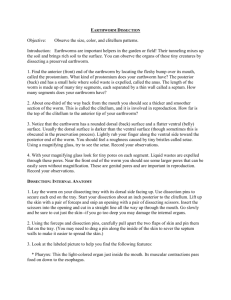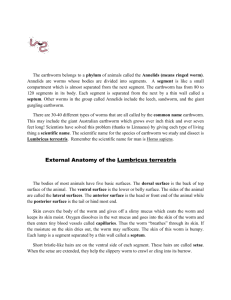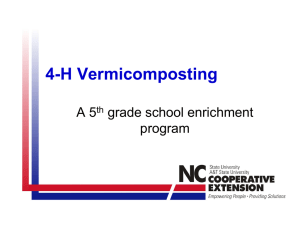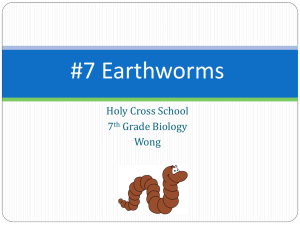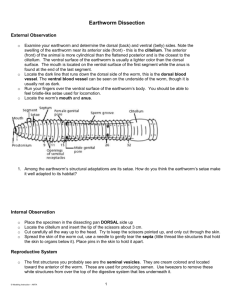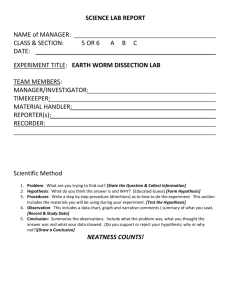Earthworm Dissection Instructions
advertisement
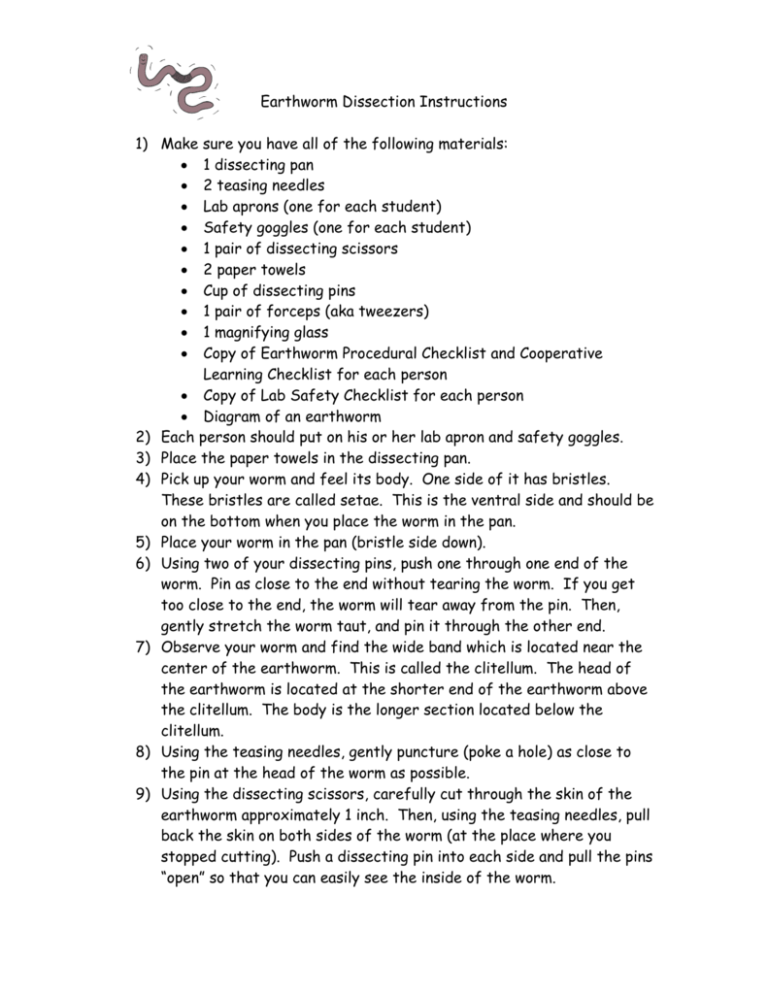
Earthworm Dissection Instructions 1) Make • • • • • • • • • • 2) 3) 4) 5) 6) 7) 8) 9) sure you have all of the following materials: 1 dissecting pan 2 teasing needles Lab aprons (one for each student) Safety goggles (one for each student) 1 pair of dissecting scissors 2 paper towels Cup of dissecting pins 1 pair of forceps (aka tweezers) 1 magnifying glass Copy of Earthworm Procedural Checklist and Cooperative Learning Checklist for each person • Copy of Lab Safety Checklist for each person • Diagram of an earthworm Each person should put on his or her lab apron and safety goggles. Place the paper towels in the dissecting pan. Pick up your worm and feel its body. One side of it has bristles. These bristles are called setae. This is the ventral side and should be on the bottom when you place the worm in the pan. Place your worm in the pan (bristle side down). Using two of your dissecting pins, push one through one end of the worm. Pin as close to the end without tearing the worm. If you get too close to the end, the worm will tear away from the pin. Then, gently stretch the worm taut, and pin it through the other end. Observe your worm and find the wide band which is located near the center of the earthworm. This is called the clitellum. The head of the earthworm is located at the shorter end of the earthworm above the clitellum. The body is the longer section located below the clitellum. Using the teasing needles, gently puncture (poke a hole) as close to the pin at the head of the worm as possible. Using the dissecting scissors, carefully cut through the skin of the earthworm approximately 1 inch. Then, using the teasing needles, pull back the skin on both sides of the worm (at the place where you stopped cutting). Push a dissecting pin into each side and pull the pins “open” so that you can easily see the inside of the worm. 10) Repeat step 9 over and over until you have reached the end of the worm and you can easily view all of the worm’s “contents.” 11) You should see a long line of soft, black material in the lower end of the worm. This is soil! Each student in the group should get a “pinch” of this soil and feel it. Discuss with other members of your group how the soil feels. 12) Now, using your forceps and magnifying glass, remove the organs located at the upper end of the earthworm and observe them. If a diagram of the earthworm is available, use it to locate and identify each organ. 13) When you have completed each of the steps above you are finished, and it’s time to clean up! Members of your group should remove the pins from the worm and place them in the cup. Roll the worm up in the paper towel and throw it away. Place all of the dissecting materials back in the pan, and return them to the appropriate area (ask your teacher if you’re not sure where). Make sure your area is completely clean. Your goggles will need to be cleaned, and your teacher should give you instructions concerning how to clean them or what to do with them. 14) When everything is back in its place, you should then make sure you have completed the Earthworm Dissection Procedural Checklist and Cooperative Learning Checklist as well as the Lab Safety Checklist, signed them and turned them in to your teacher. Want to know more about earthworms? Check out this fun web site: http://yucky.kids.discovery.com/ Earthworm Dissection Procedural Checklist Place a check next to each of the following items you completed during the Earthworm Dissection Lab Activity. If there were any problems or one of these items was not completed, please explain why in the comment section below this checklist. _____ Each person in the group wore their lab apron and safety goggles throughout the activity. _____ The paper towels were placed in the pan. _____ Each person felt the body of the worm and found its ventral side. _____ The worm was pinned at each end very carefully. _____ We were able to locate the earthworm’s clitellum. _____ We cut and pinned the entire length of the worm. _____ Each person in the group obtained a “pinch” of soil from the body of the worm and participated in the group discussion about how the soil felt. _____ Each person took a turn using the forceps to remove one or more of the worm’s organs and attempted to identify them. _____ Each person in the group helped clean up the lab area at the conclusion of the activity. Comments: Please list below two ways earthworms are important us. (Think about what they do to the soil.): 1. ____________________________________________________ 2. ____________________________________________________ Cooperative Learning Checklist _____ I listened to each person’s ideas without making negative comments. _____ Each person in the group was allowed to participate in the dissection. Please comment on how you think each person did in the activity: I was as honest as possible when I completed the checklists above. ___________________________________ Student Signature _____________ Date LAB SAFETY CHECKLIST _____ I wore my lab apron and safety goggles throughout the activity. _____ I did not begin the activity until my teacher told me it was okay to begin. _____ I followed all of the directions for the activity exactly as they were given to me. _____ I did not taste any of the lab materials during the activity. _____ I was very careful when it was my turn to handle the sharp instruments. _____ I stayed with my group, took this activity seriously, and did not run around the room or act inappropriately during the activity. (In other words, I was not involved in any “horseplay.”) _____ I helped my group clean up following the lab activity. _____________________________________ ______________ Student Signature Date
